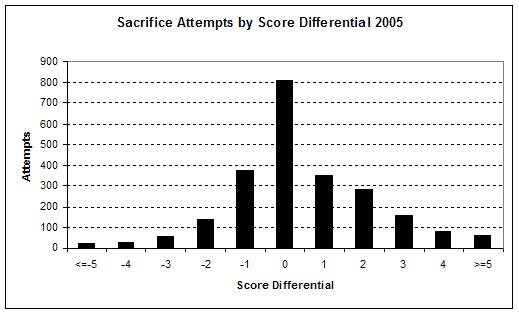In case you missed it you should check out Dave Studeman's article that looks deeper at Defensive Efficiency Rating - "Inside DER" over on THT.
One of the things that should be of interest to Cubs fans is his mention of Mark Prior's outs on ground ball rate. He shows that Prior's out percentage on ground balls was just 65.8% in 2004 whereas the league average, as I've mentioned before, is around 75%. He also has posted Prior's full stats on his wonderful baseball graphs site. What's interesting, of course, is that Prior is uncommon in that this appears to be consistent from year to year. For most pitchers this simply isn't the case as he says...
"Not surprisingly, pitchers who give up more line drives have lower DERs and those who have more infield flies have higher DERs. But the thing is, at least for this bunch of pitchers (2003-2005), batted-ball types weren't that important. The R-squared between batted-ball types and DER was only .10. That means that only 10% of the difference in pitcher DER could be explained by the types of batted balls they allowed. The other 90%? Well..."
I did a little digging and came up with the following table of out% on ground balls from some of the Cubs starters over the past few years (I've included errors as outs in order to discount that difference since indeed Prior has had more errors committed on grounders than other Cubs pitchers. You'll notice this raises the league average over 75% to the 76-79% range). The data is from BIS. The column "-Prior" shows the Cubs rate when you don't include Prior.
Year Prior Wood Maddux Zambrano Clement -Prior Lg
2003 0.761 0.781 - 0.792 0.829 0.786 0.785
2004 0.685 0.731 0.798 0.772 0.767 0.765 0.762
2005 0.745 0.821 0.796 0.801 - 0.774 0.767
So Mark Prior has been consistently the lowest, Greg Maddux and Carlos Zambrano consistently high. Kerry Wood and Matt Clement all over the map.
And that begs the question of why it is that Prior tends to give up more hits on groundballs?
What springs to mind are two contradictory theories.
The more likely I assume is that he gives up harder hit ground balls that end up making it through the infield. In Studeman's presentation of the data this is supported by the fact that his line drive rates are a bit higher than the ML average from 2002 through 2005. In watching him pitch this may be related to the fact that he tends to nibble so much early in the count that he often ends up throwing fastballs in 2-1 and 3-2 counts that are easier to hit hard.
But the inverse theory would hold that Prior allows more hits on grounders because he saws off more bats which results in more infield hits.
Which is true?
In thinking about this it occurred to me that in either case the play by play data we have is not sufficiently granular to determine between them. That's the case since at least some of the hard hit ground balls would be knocked down by infielders and so we wouldn't be able to tell whether a hit resulted from being a hard-hit shot that was knocked down by an infielder or a nubber that the infielder couldn't make a play on.
In any case I did a little more digging using PBP data from a different source and broke down the number of ground balls each pitcher gave up that were fielded by infielders and what percentage of those balls resulted in hits.
Balls Fielded by Infielders
Name GB H Pct
Greg Maddux 612 45 0.074
Kerry Wood 357 28 0.078
Matt Clement 462 29 0.063
Carlos Zambrano 795 64 0.081
Mark Prior 408 39 0.096
What you can see from this is that indeed in the period 2003-2005 Prior gave up infield hits 1.5% more often than any other Cubs pitcher and 2.3% more often than Greg Maddux on groundballs. But since we don't know how hard these balls were hit we don't know which theory is true.
Royals fans will notice that Jose Lima was near the top of Studeman's list with a ground out% of 82.6% in 2004. That certainly helps explain his "resurgent" season with the Dodgers and doesn't make Allard Baird look any better for signing him.
Cubs fans will also note that Glendon Rusch's fly ball out% of just 51.6% with the Brewers in 2003 made him a good pickup for the Cubs in 2004 as I noted in my earlier post on DIPS for 2005.



125x125_10off+copy.jpg)


